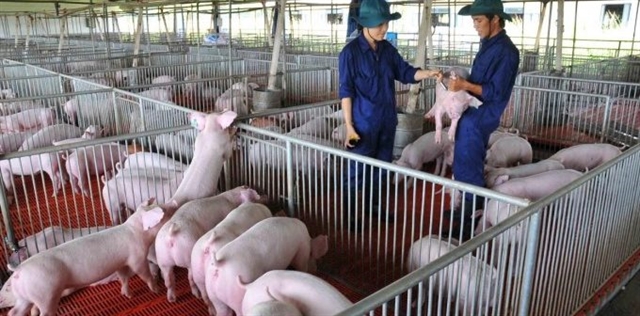
HÀ NỘI — The recent increase in price of animal feed has brought more difficulties for the livestock production of businesses and farmers.
After the Tết (Lunar New Year) holiday, many animal feed products have seen a new price increase due to the impact of the higher world price of raw materials for animal feed production compared to the end of 2021.
Specifically, the price has increased by about 22 per cent for soybean oil, 21 per cent for soybeans, 16 per cent for soybean meal and 9 per cent for corn.
The main reason is due to the influence of adverse weather in the main growing areas in South American countries which provide a large volume of raw materials for feed production in the world.
Transportation costs are also constantly increasing because of petrol and oil price hikes. In addition, the conflict between Russia and Ukraine is having a great impact on corn and wheat prices at home and abroad.
The most favoured nation (MFN) tariff for some imported animal feed products has been reduced from the end of 2021 such as from 3 per cent to zero for wheat and from 5 per cent to 2 per cent for corn.
However, the cost of animal feed accounts for 65-70 per cent of the production cost in the livestock sector. Therefore, the record increase of those prices of animal feed materials has caused huge difficulties and challenges for the domestic livestock industry, especially pig farming.
“With the price of raw materials for animal feed production increasing from 2021 to now, the prices of finished animal feed products have risen by 18-22 per cent. The increase in animal feed prices has made the profit of farmers plummet, and even some households and farms suffer losses,” said Tống Xuân Chinh, an official from Ministry of Agriculture and Rural Development (MARD).
Reducing the animal feed prices by 3 per cent could make the livestock production cost fall by 2 per cent, according to Chinh who is deputy director of the MARD’s Livestock Production Department.
At a recent conference on solutions for developing sustainable pig production and the management of animal feed production and trade held by MARD, experts said the reduction of import tax on animal feed is only an immediate solution. Production of raw materials at home is a long-term solution for the domestic livestock industry.
Local enterprises in the livestock industry are encouraged to invest in the application of high technology and biotechnology to quickly produce chemicals and biological products as raw materials for pig feed. Those products would replace natural animal feed sources and imports. Besides that, they need to make efficient use of locally available raw materials.
However, Dương Tất Thắng, director of the Livestock Production Department, said the livestock industry lacks efficient cooperation and livestock production chains.
“The industry mainly has small-scale livestock production and the development of professional and modern production processes is limited,” Thắng said.
There is a lack of market information and forecasting so most farmers are still passive and dependent on traders and the intermediary stage, he said.
On the other hand, Việt Nam has signed 17 free trade agreements, including new generation trade agreements such as the CPTTP and EVFTA or bilateral agreements with many countries with advanced livestock production.
Therefore, it will be more difficult for domestic livestock products, including pork products, because Việt Nam is forced to open its market for food imported from the US, Brazil, Russia, India and Germany. Domestic products, therefore, face strong competition with imported goods.
However, according to the MARD, Việt Nam’s pig industry has a large consumption market with nearly 100 million people and 15-18 million tourists per year that could increase in the coming years. In addition, mainland China, Hong Kong, Taiwan and Malaysia are potential import markets for Việt Nam’s pork products.
So far, Việt Nam’s livestock sector has contributed 25.2 per cent of GDP to the agricultural sector.
More and more Vietnamese and foreign enterprises have invested in the development of animal husbandry production and food processing chains, including Masan, Dabaco, Tân Long, Trường Hải, Hòa Phát, CP, Deheus and Japfacomfeed. — VnExpress News
- Reduce Hair Loss with PURA D’OR Gold Label Shampoo
- Castor Oil Has Made a “Huge” Difference With Hair and Brow Growth
- Excessive hair loss in men: Signs of illness that cannot be subjective
- Dịch Vụ SEO Website ở Los Angeles, CA: đưa trang web doanh nghiệp bạn lên top Google
- Nails Salon Sierra Madre
 VnExpress News The News Gateway of Vietnam
VnExpress News The News Gateway of Vietnam




